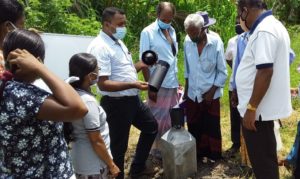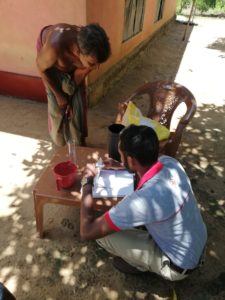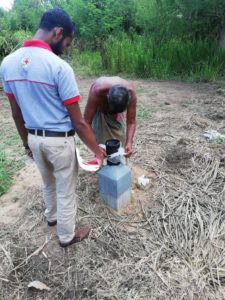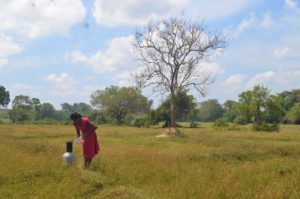Collective Effort in Adapting to Changing Climate: Water Management Through Weather Observations by the Community
By Sakshi Selvanathan and Ganga Kariyawasam (04th November 2021)
Communities in the dry zone of Sri Lanka are very much dependent on rainfall for agriculture. Therefore, keeping a record of rainfall helps, and there’s no better way to learn about the rains than observing and experiencing them firsthand. As such, the Climate Resilience Integrated Water Management Project (CRIWMP) installed 36 manual rain gauges[1] in the Kurunegala district to help communities measure rainfall. The project further provided them with training sessions on recordkeeping and the use of data in water management.
In the usual practice, water collected in the tank[2] is released by the ‘Water Controller’ of the respective farmer organization to the farmer fields according to the cultivation plan. In this exercise, they would determine date of the water issue after a rainfall based on their experience and traditional knowledge. However this practice does not count the actual requirement – thus, a considerable amount of water was wasted.
Sasanka Dinesh, living in Athaudagama Village in Polpithigama, is the President of Saliya Athaudagama farmer organization. He is one of the privileged farmers who deeply appreciates the new facility: “The project trained us on how to record and use the rainfall data in our irrigation issues. After measuring the amount of the rain fall, the Water Controller decides the irrigation interval with a small calculation. Based on that, he releases water to cultivation fields from the irrigation tank,” says Sasanka confidently. “There are four manual rain gauges in our Mamunuwa cascade[3]. A community member is allocated for each gauge and is responsible for record keeping and maintenance.”
There are few manual rain gauges in a cascade focusing each tank, since there is rainfall variation even within the same village due to climate change. This leads the farmer organization to make specific decisions for water management of each tank. Ultimately this process helps to strengthen and empower water users and their organizations to engage in sustainable management of water resources.
Samantha, a female farmer and a member of the Kapuhengama farmer organization, is responsible for one of the rain gauges in the Kadawala cascade in Galgamuwa. “The project trained us how to get the reading, record keeping and maintenance of the rain gauge on a daily basis. Moreover, we learned the importance of this data to water management in the tanks used for the cultivation”, Samantha said.
Collective action supported these communities to plan their cultivation with changing weather patterns. And it further facilitated these communities to use water collected in the tank efficiently and effectively in irrigation with minimum wastage, eventually saving water too. In the long run, this helps to increase the adaptive capacities of farmers to face new climatic variabilities and shocks, and to enhance the resilience of farming practices and improved water management to withstand the droughts and floods rife in Sri Lanka.
About the Climate Resilient Integrated Water Management Project (CRIWMP)
The Sri Lanka Red Cross Society mobilizes farmer communities in the dry zone to adopt climate resilient agricultural activities. The Climate Resilient Integrated Water Management Project is a 7-year project aimed at strengthening the resilience of Smallholder Farmers in Sri Lanka’s Dry Zone to climate variability and extreme events.
The Project is financed through a grant received from Green Climate Fund (GCF) while the Government of Sri Lanka has committed to co-finance the activities identified under the Project as well. Ministry of Mahaweli Development and Environment, is an implementing partner for this project, with technical assistance of the United Nations Development Program (UNDP) and work with a number of government institutions to deliver the project activities and outputs while measuring its’ impact.
[1] A rain gauge is a type of instrument used to measure rainfall rate in a certain period of time. Manual rain gauge is a simple tube, closed on one end and calibrated in millimeters to indicate the amount of liquid. Rainfall amount is described as the depth of water reaching the ground, typically in inches or millimeters (25 mm equals one inch).
[2] Tank (locally called as “Wewa”) is a man-made reservoir to store water from a seasonal stream mainly for irrigation, then for domestic and other needs of the village, and is a part of ancient irrigation system in Sri Lanka.
[3] A ‘Cascade system’ or locally known as ‘Ellangawa’ is a connected series of tanks organized within a micro-catchment of the dry zone in Sri Lanka. It is the traditional unit used in the management of tanks.



